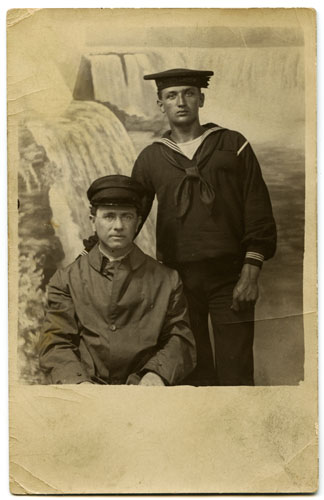Fort Mandan State Historic Site is temporarily closed for maintenance until further notice.
Introduction | Work | Education | Athletics | Social Events | Fire & Engine Trouble |
Gunnery Practice | Activities

The USS North Dakota was launched on November 10, 1908. About 150 of the most important political and business figures from the state of North Dakota traveled to Quincy, Massachusetts to honor the ship at the ceremony. She had been named for this state following a long-standing tradition of naming ships for each state in the Union.
This new dreadnought (DRED-NAWT), the first all-big-gun ship in the US Navy, was the biggest, heaviest, and fastest battleship yet built by any navy in the world. Though it was modeled after a British battleship, the design came from an American Navy officer, Commander Homer C. Poundstone. The North Dakota had ten 12 inch guns which could be turned to face the enemy in any direction. The sailors were also trained to repel torpedo attacks and possible attacks from airplanes which were used as military weapons by 1915.
The USS North Dakota was completed and commissioned on April 11, 1910. Over the next thirteen years, she sailed along the east coast of the United States, the Caribbean Sea, the coast of Mexico, northern Europe, and to Guantanamo Bay, Cuba. She patrolled the east coast from Virginia to Long Island during World War I, and trained midshipmen from the US Naval Academy. She toured ports on the Mediterranean Sea in 1919. Her crew took honors in target practice on the open sea, hitting targets as far as 10 miles away at a rate exceeding thirty per cent. The ship, however, was also troubled by engine breakdowns including a major explosion and fire in September 1910.

The ship was home to more than 900 officers and enlisted men. The officers, usually educated at the Naval Academy, were leaders who headed up every division of the ship. The enlisted men were the ones who took orders from the officers. Most had enlisted for four years, but some would spend their entire careers in the Navy.
With so many men on board, the ship became a small city at sea. All of the personal needs of the men had to be met on board, and the ship’s work had to be completed in an orderly and timely manner. Very few letters or other documents remain from the men who served on the USS North Dakota; but, there are many small pieces of evidence, or incomplete pieces of information, that help us understand how the men went about their work, how they spent their leisure time, and what it was like to live aboard a large and powerful battleship. The evidence about life on the ship mostly comes from newspaper articles published while the ship was active; other evidence can be seen in photographs or a few documents that were produced on the ship.
The USS North Dakota, which never saw combat, was taken out of service in 1923 to satisfy the requirements of the Washington Naval Arms Limitation Treaty which tried to put an end to the naval arms race of the early twentieth century. In 1931, the ship was taken apart for scrap, but we can still study her history and discover what life was like in a floating community.
Address:
612 East Boulevard Ave.
Bismarck, North Dakota 58505
Get Directions
Hours:
State Museum and Store: 8 a.m. - 5 p.m. M-F; Sat. & Sun. 10 a.m. - 5 p.m.
We are closed New Year's Day, Easter, Thanksgiving Day, Christmas Eve, and Christmas Day.
State Archives: 8 a.m. - 4:30 p.m. M-F, except state holidays; 2nd Sat. of each month, 10 a.m. - 4:30 p.m. Appointments are recommended. To schedule an appointment, please contact us at 701.328.2091 or archives@nd.gov.
State Historical Society offices: 8 a.m. - 5 p.m. M-F, except state holidays.
Contact Us:
phone: 701.328.2666
email: history@nd.gov
Social Media:
See all social media accounts